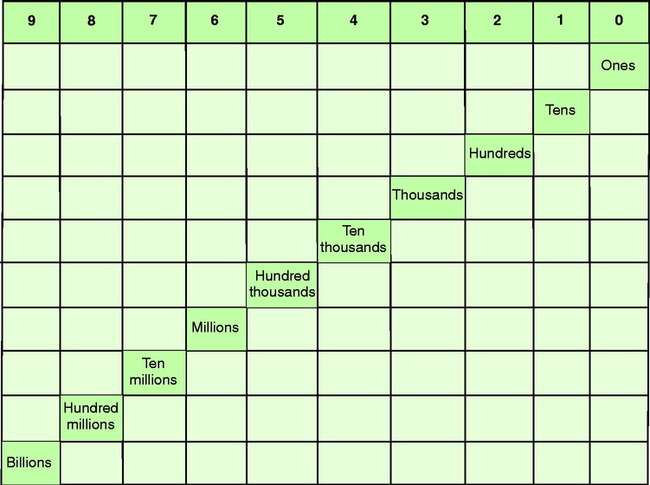Upon completion of this chapter, the learner will be able to: 1. Define the key terms that relate to basic mathematical computations. 2. Calculate basic addition, subtraction, multiplication, and division with 100% accuracy. 3. Perform calculations with both positive and negative integers with 100% accuracy. 4. Define and demonstrate when exponents can be used. 5. Calculate multiplication and division with exponents with 100% accuracy. 6. Perform mathematical sentences using the order of operation theory. 7. Identify greatest common factors, least common multiple, and prime numbers. Any number being added. To combine two or more numbers. Calculation using addition, subtraction, multiplication, and division. Associative Property of Addition The sum stays the same when the grouping of addends is changed. Associative Property of Multiplication The product stays the same when the grouping of factors is changed. The repeated factor that is to be multiplied by itself. Regroup from one place value to a lower place value in order to subtract. Move an extra digit from one place value column to the next. A number that is a multiple of two or more numbers. Commutative Property of Addition The sum stays the same when the order of the addends is changed. Commutative Property of Multiplication The product stays the same when the order of the factors is changed. The process of computing. To find a numerical result, usually by adding, subtracting, multiplying, or dividing. The amount that remains after one quantity is subtracted from another. Any one of the 10 symbols used in mathematical computations: 0, 1, 2, 3, 4, 5, 6, 7, 8, 9. A number with a positive or negative sign to show the direction it lies from 0. When one of the factors of a product is written as a sum, multiplying each addend before adding does not change the product. To separate into equal groups. A quantity to be divided. One number is divisible by another if its quotient is an integer. The operation of making equal groups. The quantity by which another quantity is to be divided. A statement that two mathematical expressions are equal. To find the value of a mathematical expression. The number that determines how many times the base will be multiplied. An integer that divides evenly into another. The largest number that divides evenly into two or more numbers. If you add 0 to a number, the sum is the same as the given number. Identity Property of Multiplication If you multiply a number by 1, the product is the same as the given number. Whole numbers and their opposites. The smallest common multiple of a set of two or more numbers. Computing an exact answer without using paper and pencil or physical aids. In subtraction, the number from which you subtract. The product of a whole number and any other whole number. In multiplication, the factor being multiplied by another (the multiplier). The operation of repeated addition. In multiplication, the factor by which another (the multiplicand) is multiplied. Numbers less than 0. An equation or inequality with numbers. Addition, subtraction, multiplication, division, raising to a power, and taking a root are mathematical operations. Rules describing what sequence to use in evaluating expressions. The value of the position of a digit in a number. Numbers that are greater than 0. An exponent. A number with 10 as a base and a whole number exponent. A number that has exactly two different positive factors, itself and 1. The result of multiplication. The result of division. Two numbers that have the same product. In whole number division, when you have divided as far as you can without using decimals, what has not been divided yet is the remainder. An operation that gives the difference between two numbers. Subtraction is also used to compare two numbers. In subtraction, the number being subtracted. The result of addition. Something that represents something else. Examples include: +, -, ×, ÷. Any number that does not include a fraction, decimal, or negative sign, for example, 0, 1, 2, 3. Two numbers whose sum is 0. The product of any number and 0 is 0. Math, just the term, whether positive or negative, initiates some type of response. You might be a student who enjoys math or at least has confidence in your mathematical abilities. Others avoid math like the plague. They lack confidence in their abilities; however, if you ask them a question, they know the answer. Why do people avoid using math? The answer has something to do with their confidence in recognizing mathematical computations. Most people perform some type of mathematical computation every day. Examples include: • Adding up the total cost of a purchase • Figuring out how much it will cost to fill up the gas tank • Figuring out medication dosages • Collecting deductibles or copayments at the time of service • Performing an inventory of office equipment • Ordering nonreusable equipment • Preparing the office staff payroll In this section we will be dealing with whole numbers and the different operations in which we manipulate them. As a reminder, the order of the numbers represents the different place values of each digit. Many students prefer to rewrite math problems in a vertical format so that the number place values match up (Figure 1-1).
Basic Math Review
OBJECTIVE 1
OBECTIVE 2
Review of basic mathematical operations
Basic Math Review
Get Clinical Tree app for offline access


 MATH ETIQUETTE 1-1
MATH ETIQUETTE 1-1 MATH TRIVIA 1-1
MATH TRIVIA 1-1 PRACTICE THE SKILL 1-1
PRACTICE THE SKILL 1-1









 HUMAN ERROR 1-1
HUMAN ERROR 1-1
 STRATEGY 1-1
STRATEGY 1-1




 MATH TRIVIA 1-2
MATH TRIVIA 1-2 PRACTICE THE SKILL 1-2
PRACTICE THE SKILL 1-2











